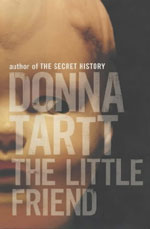History Repeating | |

| A decade coming, the follow-up to The Secret History also begins in the past, the unsolved hanging of red-haired child Robin Cleves. In the Mississippi of the late Seventies and early Eighties, it seems like a relic from the distant past, propelled into the present by the modern consciousness of his sister Harriet who has grown to inherit its repercussions. We are also party to this inherited milieu, a Mississippi straight out of Tom Sawyer - mixed with references to permanents and dial-a-prayer. A pool-scene is reminiscent of Raging Bull, a pool-hall of The Accused, a family dinner straight out of The Texas Chainsaw Massacre. Tartt catches the dialect well. At the edges are details from a thousand blues and folk songs; Parchman, dirt roads, pines. Harriet navigates by children's books and her nanny's rhymes. The greatest achievement of The Little Friend is the two wonderful lead characters. Hely is hopelessly in love with Harriet but his horror comics and James Bond films cannot compare with the real tragedy in her life. She's the real thing. There's something wonderfully Gashlycrumm Tinies about her, lying in a self-built grave covered in leaves. Her life is both homely and threatening. Aunts mill around eccentrically, but photos of Robin are kept hidden in a heart-shaped box. Since his loss time does not pass linearly. Harriet's sister Allison is a dreamy Proserpina lost to the world of sleep and reluctant to be drawn to the middle of the bridge to communicate while their mother is sedated until she mistakes day and night. As Harriet practises holding her breath like Houdini her mental tricks are like a screensave on the other side of which something terrible might be happening unseen. Disorientation from heatstroke, poisoning and methamphetamine abuse throws the past and present into contest, cats try to talk English and a preacher's bumper sticker reads THIS WORLD IS NOT MY HOME! If the narrative is digressive then so is the interrelated community. Harriet's mission is curtailed by her status as a child, often banked in by stacked prose. As her aunt says at one point, 'It's awful being a child, at the mercy of other people'. As well as having the best plot in recent memory, The Secret History was also incredibly funny. The Little Friend has numerous great moments and vivid glimpses; Never before had they seen a living soul in that wasteland - except, once, a tiny black boy in red underpants who, bent at the knee, had chunked a rock underhand at them and then tottered back, shrieking, into the underbrush. It was a lonely spot, and neither Harriet nor Hely enjoyed playing there, though neither admitted it. Tartt is skilled at little moments like his, recognisable scenes like the burn from melted cellophane from a cigarette pack, cats meowing as they pad round the house looking for someone missing. As she says of Harriet, 'her imagination was so vivid that she could never be quite sure what she actually remembered, and what her fancy had coloured in to fill the blanks.' The book is one long hard stare at death and our status between living and dying in which we sense as the narrative progresses that, as mid-way through Stand By Me, the search is only going to reveal the kid who was dead all along. As frightening as the reality is, when Harriet chooses the known horror she has outgrown - Summer Camp - over admitting to her feelings for a departing nanny, she is aware that she makes a mistake. Adults, for the most part distracted by their own concerns, are separated from, and linked to, children's worlds. It is only before a tragedy is broken to her that Harriet is called the pet name she has longed to hear. By the end, her life seems so stifling that you long for a bloodletting; but life isn't so simple. This mobius strip of a book is funny and exciting, with scenes to rival it's predecessor and the most pleasing ending I have read since Anita Brookner's Lewis Percy. © 2002 Matt Bryden |